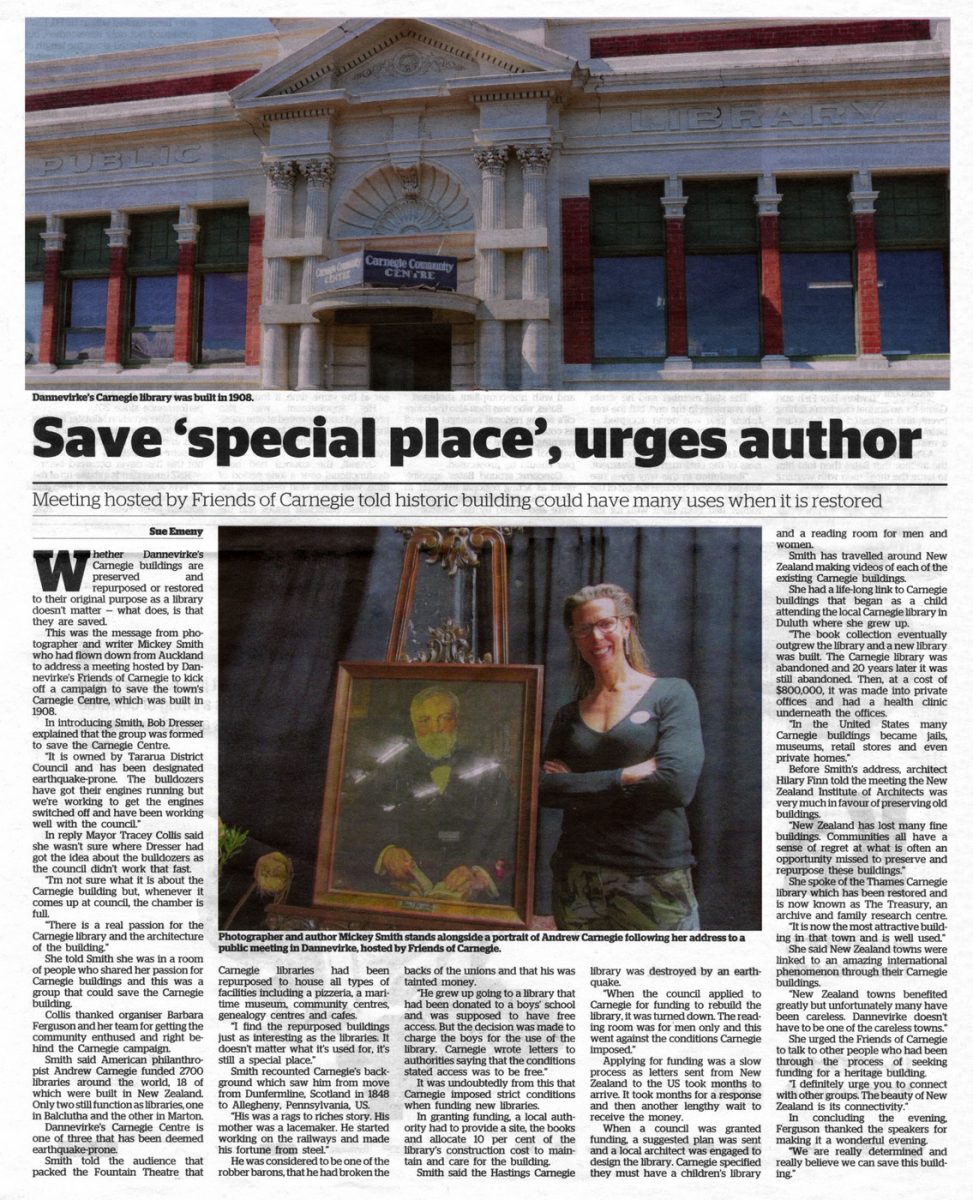Save ‘special place’, urges author
Meeting hosted by Friends of Carnegie told historic building could have many uses when it is restored
Sue Emeny
Whether Dannevirke’s Carnegie buildings are preserved and repurposed or restored to their original purpose as a library doesn’t matter – what does, is that they are saved.
This was the message from photographer and writer Mickey Smith who had flown down from Auckland to address a meeting hosted by Dannevirke’s Friends of Carnegie to kick off a campaign to save the town’s Carnegie Centre, which was built in 1908.
In introducing Smith, Bob Dresser explained that the group was formed to save the Carnegie Centre.
“It is owned by Tararua District Council and has been designated earthquake-prone. The bulldozers have got their engines running but we’re working to get the engines switched off and have been working well with the council.”
In reply Mayor Tracey Collis said she wasn’t sure where Dresser had got the idea about the bulldozers as the council didn’t work that fast.
“I’m not sure what it is about the Carnegie building but, whenever it comes up at council, the chamber is full.
“There is a real passion for the Carnegie library and the architecture of the building.”
She told Smith she was in a room of people who shared her passion for Carnegie buildings and this was a group that could save the Carnegie building.
Collis thanked organiser Barbara Ferguson and her team for getting the community enthused and right behind the Carnegie campaign.
Smith said American philanthropist Andrew Carnegie funded 2700 libraries around the world, 18 of which were built in New Zealand. Only two still function as libraries, one in Balclutha and the other in Marton.
Dannevirke’s Carnegie Centre is one of three that has been deemed earthquake-prone.
Smith told the audience that packed the Fountain Theatre that Carnegie libraries had been repurposed to house all types of facilities including a pizzeria, a maritime museum, community centres, genealogy centres and cafes.
“I find the repurposed buildings just as interesting as the libraries. It doesn’t matter what it’s used for, it’s still a special place.”
Smith recounted Carnegie’s background which saw him from move from Dunfermline, Scotland in 1848 to Allegheny, Pennsylvania, US.
“His was a rags to riches story. His mother was a lacemaker. He started working on the railways and made his fortune from steel.”
He was considered to be one of the robber barons, that he had broken the backs of the unions and that his was tainted money.
“He grew up going to a library that had been donated to a boys’ school and was supposed to have free access. But the decision was made to charge the boys for the use of the library. Carnegie wrote letters to authorities saying that the conditions stated access was to be free.”
It was undoubtedly from this that Carnegie imposed strict conditions when funding new libraries.
In granting funding, a local authority had to provide a site, the books and allocate 10 per cent of the library’s construction cost to maintain and care for the building.
Smith said the Hastings Carnegie library was destroyed by an earthquake.
“When the council applied to Carnegie for funding to rebuild the library, it was turned down. The reading room was for men only and this went against the conditions Carnegie imposed.”
Applying for funding was a slow process as letters sent from New Zealand to the US took months to arrive. It took months for a response and then another lengthy wait to receive the money.
When a council was granted funding, a suggested plan was sent and a local architect was engaged to design the library. Carnegie specified they must have a children’s library and a reading room for men and women.
Smith has travelled around New Zealand making videos of each of the existing Carnegie buildings.
She had a life-long link to Carnegie buildings that began as a child attending the local Carnegie library in Duluth where she grew up.
“The book collection eventually outgrew the library and a new library was built. The Carnegie library was abandoned and 20 years later it was still abandoned. Then, at a cost of $800,000, it was made into private Offices and had a health clinic underneath the offices.
“In the United States many Carnegie buildings became jails, museums, retail stores and even private homes.”
Before Smith’s address, architect Hilary Finn told the meeting the New Zealand Institute of Architects was very much in favour of preserving old buildings.
“New Zealand has lost many fine buildings. Communities all have a sense of regret at what is often an opportunity missed to preserve and repurpose these buildings.”
She spoke of the Thames Carnegie library which has been restored and is now known as The Treasury, an archive and family research centre.
“It is now the most attractive building in that town and is well used.”
She said New Zealand towns were linked to an amazing international phenomenon through their Carnegie buildings.
“New Zealand towns benefited greatly but unfortunately many have been careless. Dannevirke doesn’t have to be one of the careless towns.”
She urged the Friends of Carnegie to talk to other people who had been through the process of seeking funding for a heritage building.
“I definitely urge you to connect with other groups. The beauty of New Zealand is its connectivity.”
In concluding the evening, Ferguson thanked the speakers for making it a wonderful evening.
“We are really determined and really believe we can save this building.
Photo captions –
Dannevirke’s Carnegie library was built in 1908.
Photographer and author Mickey Smith stands alongside a portrait of Andrew Carnegie following her address to a public meeting in Dannevirke, hosted by Friends of Carnegie.












Do you know something about this record?
Please note we cannot verify the accuracy of any information posted by the community.